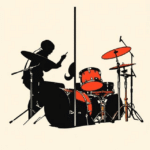Unleash Your Inner Musician: A Deep Dive into Digital Audio Workstations (DAWs)
Imagine a producer, headphones on, eyes glued to a screen. They’re crafting a hit song, layering sounds, tweaking effects, all within a single program. That’s the power of a Digital Audio Workstation, or DAW. It’s your all-in-one studio for creating music, podcasts, sound effects, and more. DAWs have made music creation open to everyone, no expensive studios are needed.
What is a Digital Audio Workstations and Why Do You Need One?
A DAW is like a digital toolbox for sound. It lets you record, edit, mix, and master audio, all on your computer. But why should you use one?
Defining a Digital Audio Workstation
Think of a DAW as your personal recording studio, but inside your computer. Years ago, making music meant bulky hardware, like tape recorders and mixing boards. Now, DAWs bring all those tools together in one piece of software. This shift has changed how music is created, making it more accessible and affordable for those with creative dreams.
Core Functions: Recording, Editing, Mixing, and Mastering
A Digital Audio Workstations lets you do a lot of things with sound. Recording is capturing audio from a microphone or instrument. Editing involves chopping, changing, and arranging those recordings. Mixing is balancing the levels of different sounds. Mastering is the last step, making the track sound its best for the world. For example, you might record your guitar, cut out any mistakes, balance it with the drums, and then make the whole song louder and clearer.
Benefits of Using a DAW: Flexibility, Cost-Effectiveness, and Collaboration
Compared to old-school studios, DAWs offer many perks. You can use plugins to add instruments and effects. It’s way cheaper than renting a studio. Plus, you can work with people from all over the world online. No need to be in the same room to make music together.
Popular DAWs: A Comparison
Many DAWs are out there, each with its own feel and strengths. Here are a few popular choices.
Ableton Live: The Performer’s Choice
Ableton Live is known for its unique “Session View.” It’s perfect for making music on the fly and playing live. Many electronic musicians love it. This DAW lets you change parts of a song while it is playing.
Logic Pro X: Apple’s Powerhouse for Mac Users
If you use a Mac, Logic Pro X is a solid pick. It has almost every feature you could ask for. It also works great with other Apple products. Plus, it comes with a big library of sounds to get you started.
Pro Tools: The Industry Standard
Pro Tools is a big name in the music industry. Many professional studios use it. It’s known for its detailed editing and top-notch sound quality. If you’re serious about audio, Pro Tools might be for you.
FL Studio: The Beatmaker’s Playground
FL Studio is popular with hip-hop and electronic music producers. Its easy-to-use design and pattern-based system makes beatmaking simple. It’s great for making beats quickly and having fun.
Essential Features to Look for in a Digital Audio Workstations
When picking a DAW, consider these important features.
MIDI Support: Controlling Virtual Instruments
MIDI lets you control virtual instruments with a keyboard or other device. It’s key for making melodies and harmonies. Good MIDI support is a must-have.
Plugin Compatibility: Expanding Your Sonic Palette (VST, AU)
Plugins add effects, instruments, and tools to your DAW. VST and AU are common plugin formats. Make sure your DAW supports the plugins you want to use.
Audio Editing Tools: Precision and Control
Editing tools let you fix mistakes, change timing, and clean up your audio. Look for tools like trimming, stretching, and noise reduction. These are essential for getting a pro sound.
Mixing Console: Sculpting Your Sound
The mixing console is where you balance levels, EQ sounds, and add effects. It’s like the heart of your DAW. Learn how to use EQ, compression, and panning to make your music sound its best.
Tips and Tricks for Getting Started with Your DAW
New to DAWs? Here are some tips to help you learn.
Watch Tutorials and Online Courses: Learn from the Pros
YouTube and online courses are great for learning DAWs. Look for tutorials on the DAW you choose. Some good places to start include YouTube and online learning platforms.
Experiment with Presets: Discover New Sounds and Techniques
DAWs come with presets for instruments and effects. These are a quick way to find cool sounds. Don’t be afraid to try them out!
Master Keyboard Shortcuts: Speed Up Your Workflow
Keyboard shortcuts can save you a lot of time. Learn the common ones for your DAW. This will make your work faster and easier.
Understanding Audio Basics: Gain Staging, EQ, and Compression
Knowing audio basics helps you mix better. Learn about gain staging, EQ, and compression. These tools are key to getting a good sound.
The Future of DAWs: AI and Cloud Collaboration
DAWs are always changing. AI and cloud tech are bringing new possibilities.
AI-Powered Features: Intelligent Assistance for Music Production
AI can help with mixing, mastering, and even making instruments. Imagine a Digital Audio Workstations that suggests chords or fixes your mix automatically. This technology is on the horizon.
Cloud-Based Digital Audio Workstations: Collaborate and Create Anywhere
Cloud DAWs let you work on projects from anywhere. You can also work with others online. This makes collaboration easier than ever.
DAWs and Virtual Reality: Immersive Music Creation
VR could change how we make music. Imagine creating sounds in a virtual space. This could lead to totally new ways of making music.
Conclusion
DAWs are powerful tools that put a whole studio on your computer. They’re open to everyone and offer endless ways to make music. Try out different DAWs, learn the basics, and unleash your inner musician. The world of music creation is waiting for you!
For more tips on percussion instruments and to explore our premium cajon collection, visit Gappu.tv and join the rhythm revolution!


